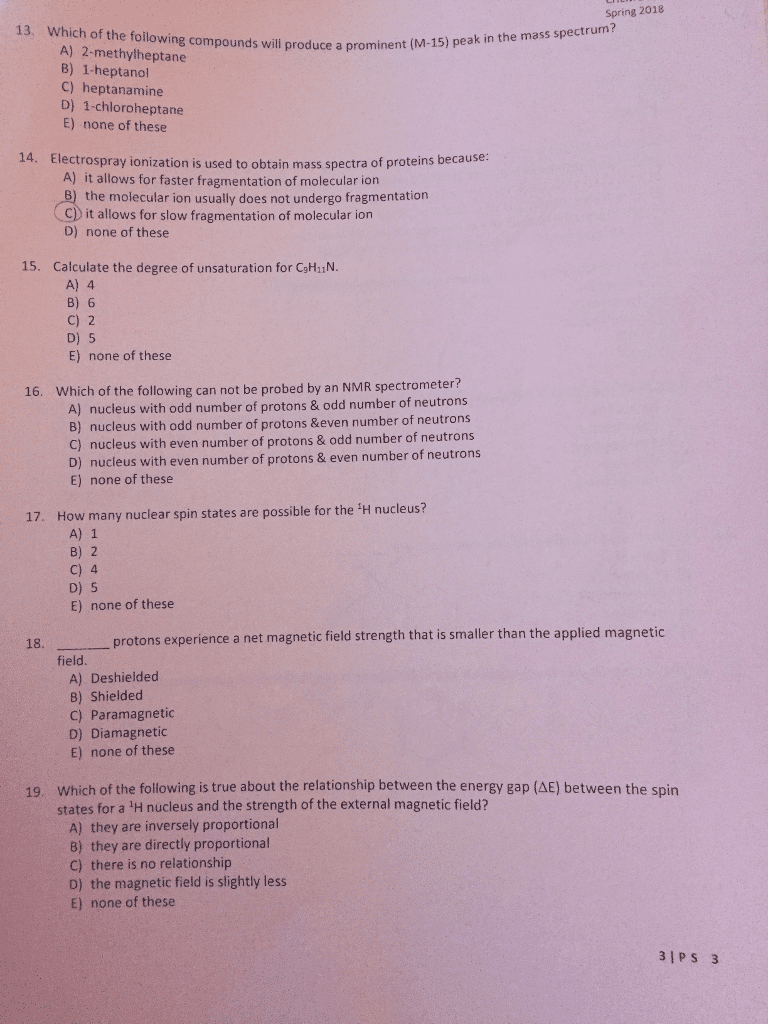CHMB42H3 Lecture Notes - Lecture 3: Spectroscopy, Bromine, Electronegativity

Monday, January 18, 2016
Chapter 15: NMR Spectroscopy
15.1 — Intro to NMR
-Nuclei that have an odd number of protons or an odd number of neutrons have a
property called spin that allows them to be studied by NMR
-Nuclei such as 12-C and 16-O do NOT have spin
-NMR means 1-H NMR (proton magnetic resonance)
-In the absence of an applied magnetic field, the magnetic moments of the nuclei are
randomly oriented
- In the presence of an applied magnetic field, the magnetic moments of the nuclei line
up with (the alpha-spin state) or against (the beta-spin state) the applied magnetic
field
-Nuclei with magnetic moments that align w/ the field are in the lower-energy alpha-
spin state, whereas those w/ magnetic moments that align against the field are in the
higher-energy
beta-spin state
(more E needed
to align the
magnetic
moments against
the field than with
it)
-The energy
difference
!1
find more resources at oneclass.com
find more resources at oneclass.com

Monday, January 18, 2016
between alpha- and beta- spin states depends on the strength of the applied
magnetic field (B nought): the greater the strength of the applied magnetic field, the
greater the deltaE
-When a sample is subjected to a pulse of radiation whose energy corresponds to the
difference in energy b/w the alpha- and beta- spin states, nuclei in the alpha-spin
state are promoted to the beta-spin state —> “flipping” the spin
-The radiation used to supply this energy is in radio frequency (rf) region of the
electromagnetic spectrum and is called rf radiation
-When the nuclei absorb rf radiation & flip their spins, they generate signals whose
frequency depends on the difference in energy b/w alpha- and beta-spin states
-The NMR spectrometer detects these signals and plots their frequency vs. their
intensity; NMR spectrum
-The nuclei are said to be in resonance w/ rf radiation, nuclear magnetic resonance
(resonance - nuclei flipping back and forth b/w alpha & beta spin states)
!2
find more resources at oneclass.com
find more resources at oneclass.com

Monday, January 18, 2016
15.2 — Fourier Transform
NMR
-A small amount of
compound is dissolved
in about 0.5mL of solvent
-This solution is put into a
long, thin glass tube &
then placed in a powerful
magnetic field
-Spinning the sample
tube about its long axis
averages the position of
the molecules in the magnetic field, which increases the resolution of the spectrum
-Pulsed Fourier transform (FT) spectrometers - has a constant magnetic field and an rf
pulse of short duration excites all the protons simultaneously
-The rf pulse covers a range of frequencies, each nucleus can absorb the frequency it
requires to come into resonance (flip its spin) & produce a signal called a free
induction decay (FID) at a frequency corresponding to deltaE.
-A computer measures the change in intensity & converts it so intensity vs. frequency
to produce a Fourier transform NMR (FT-NMR) spectrum
15.3 — Shielding Causes Different Hydrogens to Show Signals at Different
Frequencies
-In a magnetic field, the electrons circulate about the nuclei & induce a local magnetic
field that acts in opposition to the applied magnetic field & subtracts from it
-the effective magnetic field is the amount of magnetic field that the nuclei actually
“sense” through the surrounding electrons, is smaller than the applied magnetic field
-The electron density of the environment in which the proton is located shields the
proton from the applied magnetic field
-The greater is Blocal, this type of shielding is
called diamagnetic shielding
-Protons in electron-rich environments sense a
smaller effective magnetic field - require a low frequency to come into resonance &
!3
find more resources at oneclass.com
find more resources at oneclass.com
Document Summary
Nuclei that have an odd number of protons or an odd number of neutrons have a property called spin that allows them to be studied by nmr. Nuclei such as 12-c and 16-o do not have spin. Nmr means 1-h nmr (proton magnetic resonance) In the absence of an applied magnetic eld, the magnetic moments of the nuclei are randomly oriented. In the presence of an applied magnetic eld, the magnetic moments of the nuclei line up with (the alpha-spin state) or against (the beta-spin state) the applied magnetic. Monday, january 18, 2016 between alpha- and beta- spin states depends on the strength of the applied magnetic eld (b nought): the greater the strength of the applied magnetic eld, the greater the deltae. The radiation used to supply this energy is in radio frequency (rf) region of the electromagnetic spectrum and is called rf radiation.


